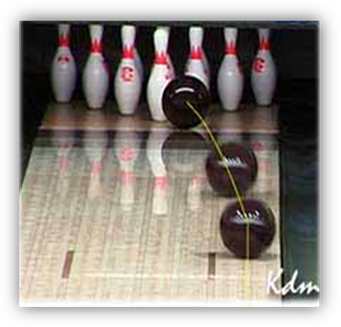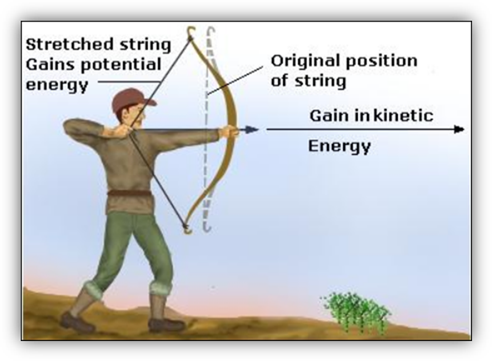
KINETIC
AND POTENTIAL ENERGY
Unit Overview
In addition to knowing the
forms of energy, there are other ways of analyzing energy, such as knowing that
energy can be stored or active.† In this unit,
we will discuss which forms of energy fall into each category.† We will then determine what factors influence
two types of stored or potential energy and what factors influence active or
kinetic energy.† Finally, the conversion
of potential to kinetic energies and vice-versa will be studied.
Work and Energy
In our last unit, we
discussed how energy can cause work to be done and work done on an object can
cause energy to be stored in the object.†
So, work and energy are related to one another in that they can be
changed from one to the other.† Letís
look at a couple of examples to make this clearer.† If a balloon is blown up, then work has been
done on the balloon, since it took some effort on your part to blow the air
into the balloon.† You had to use a
force, a push, to cause the air to leave your lungs and enter the balloon.† Now the expanded balloon has stored energy
because it has the possibility of doing work.†
If you let go of the untied balloon, it will randomly fly around the
room as the air leaves the opening.† The
air inside the balloon is doing work because it is pushing the balloon in an
opposite direction from which it is leaving the balloon.† The balloon also does work on the air because
it pushes the air out.
Suppose you have to push a
car to the side of the road because it ran out of gas.† As you push on the car, your energy does work
on the car, and you give the car energy by causing it to move.† The further you push the car, the more work
is done and the more energy it takes.†
The stored energy in your body from the food you ate, allowed your
muscles to contract to push the car.†
This is active energy because it is causing a change.† As the car moves you are transferring some of
your energy to the car, giving it active energy as well.
Potential Energy
One way to classify energy is
whether it is active or not.† If it is
not active, we say the energy is stored, waiting to be used, and stored energy
is called potential energy.† We have already stated in earlier lessons
that the energy in foods and fuels is stored by the action of
photosynthesis.† All foods and fuels
directly or indirectly receive this energy from the action of green plants,
algae, or certain bacteria. It is stored within the bonds of the molecules
within these materials.† Remember that a
molecule is a group of atoms held together by chemical bonds. This type of
energy is called chemical energy and is, therefore, a form of potential energy.†
Some scientists consider
nuclear energy to be potential energy as well.†
The energy we get from uranium and plutonium and other radioactive
elements is due to the stored energy within their nuclei, the centers of their
atoms.† Because the nuclei are not held
together very well, they tend to disintegrate by throwing off high-energy
particles and rays.† Under certain
circumstances these disintegrations can be harnessed to release a huge amount
of energy.
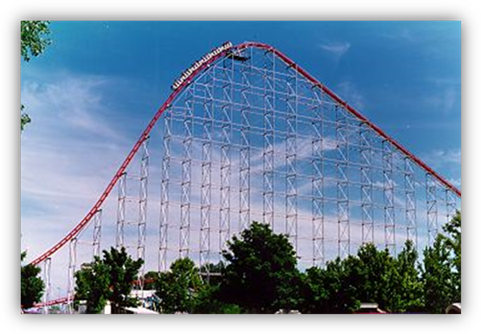 Mechanical energy, the energy of motion, can under
certain circumstances be stored.† There
are two cases that we will investigate.†
Have you ever dropped something?†
Of course, you have.† What
happened?† The object fell to the floor
or the ground.† It must have had stored
energy or it would not have been able to begin moving.† But how did it get the energy in the first
place?† Letís say the object was a ball,
and you evidently picked up the ball.† In
picking it up, you did work on the ball by lifting it.† It took a force because the ball has
weight.† The force of gravity upon the
ball causes the weight.† By doing work on
the ball, you gave the ball stored or potential energy.† This is known as gravitational potential energy because it is due to the force of
gravity upon the object.† This means that
any object that is in a position to fall has gravitational potential
energy.† This includes a rock on a cliff,
water behind a dam, a skier on a hill, or a roller coaster car at the top of a
hill.†
Mechanical energy, the energy of motion, can under
certain circumstances be stored.† There
are two cases that we will investigate.†
Have you ever dropped something?†
Of course, you have.† What
happened?† The object fell to the floor
or the ground.† It must have had stored
energy or it would not have been able to begin moving.† But how did it get the energy in the first
place?† Letís say the object was a ball,
and you evidently picked up the ball.† In
picking it up, you did work on the ball by lifting it.† It took a force because the ball has
weight.† The force of gravity upon the
ball causes the weight.† By doing work on
the ball, you gave the ball stored or potential energy.† This is known as gravitational potential energy because it is due to the force of
gravity upon the object.† This means that
any object that is in a position to fall has gravitational potential
energy.† This includes a rock on a cliff,
water behind a dam, a skier on a hill, or a roller coaster car at the top of a
hill.†
How much gravitational energy
do the riders on the roller coaster have?†
It can be calculated using a mathematical formula but for now, letís
just consider what factors might influence the amount of energy.† Why is the first hill on a roller coaster,
which is known as the lift hill, always the highest?† Because all the energy needed to keep the
coaster going throughout the entire ride must be stored in the coaster by the
time it reaches the top of the lift hill.†
Usually the greatest drop is right after that hill and it is at the
bottom of this hill that the coaster is going the fastest.† All that stored energy is being released as
motion, so the higher the hill, the more energy is stored.†
Letís look at another example
to show how height affects the amount of gravitational potential energy.† If a baseball is dropped from a height of one
foot and hits your toe, you probably would not complain because it would not
hurt.† What if it were dropped from a
height of ten feet?† You would certainly
feel it, and it might cause some pain.†
That is because more energy is stored in the ball when it is raised
higher in the air.† Therefore, we can
state that the height an object is above a surface helps determine how much
potential energy it has, but is there anything else?† Do all objects at that height have the same
potential energy?† What if the object
were a concrete block instead of a baseball?†
Even when dropped from a height of one foot, the block could do serious
injury to your toe.† That is because the
block has more energy at that height than the baseball.† Why?†
What is different?† If you think
for a while, you may decide that it is not the shape or the type of material,
but the weight of the object that influences the amount of potential
energy.† Because the block weighs a lot
more than the baseball, more work is done in raising it and therefore it has
more stored energy.† So there are two
factors that determine this gravitational potential energy, the height of the
object above the ground and weight of the object.
There is yet another type of
potential energy based upon the position of the object.† This is known as elastic potential energy.†
This type of energy exists in objects that can be compressed or squeezed
together or stretched.† Some springs for
example can be stretched, others compressed.†
Other objects that can be compressed are balls, like a basketball that
hits the gym floor.† Other objects that
can be stretched are bungee cords, trampolines, rubber bands, or bows.† If you are getting ready to shoot an arrow at
a target, you position the arrow on the bow and begin to pull back on the
bowstring.† As you pull you must exert
more and more force as you stretch the string.†
You are putting work into the bowstring, giving it elastic potential
energy.† When you release the bowstring,
it pushes against the arrow giving it the stored energy.† The arrow then begins to move, changing this
stored energy into motion.
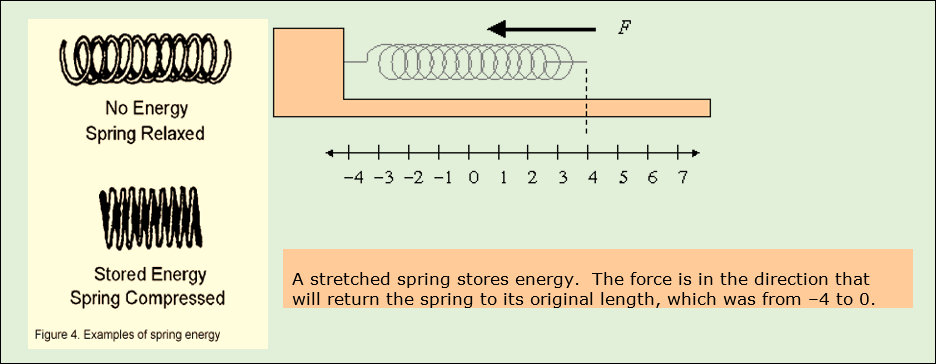
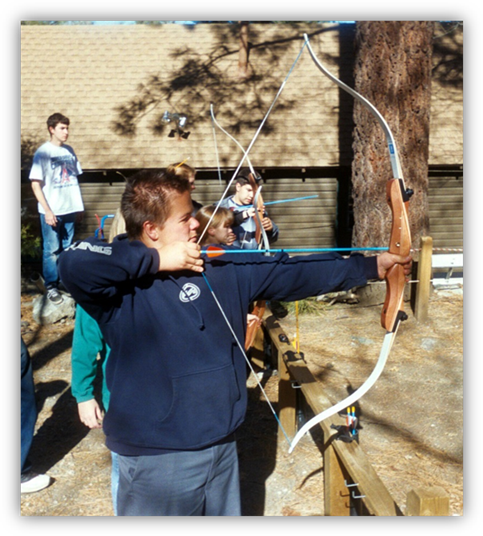
†††††
The boy in the foreground has stored potential energy
in his bow.† He did work on the bow by
pulling back on the bow.† The boy in the
background has a relaxed bow and no energy is stored in it.† In a similar manner energy is being stored in
the slingshot below.
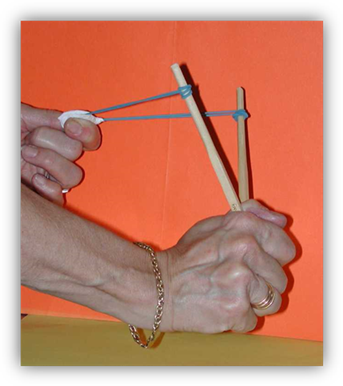
What determines how much
energy can be stored as elastic potential energy?† If you consider the work that needs to be
done to compress or stretch the object, you will agree that some objects are
easier to compress or stretch than others.†
That is due to the nature of the object; that is, it depends upon what
it is made of.† A rubber band is easier
to stretch than a bungee cord, for example.†
Another factor is how much it is compressed or stretched.† A slightly stretched bow stores less energy
than one that is stretched to its maximum.†
That is why the arrow goes further when the bow is stretched to its
maximum.† It has more energy to give to
the arrow.† So two factors are important
Ė how much the object is stretched or compressed and the material out of which
it is made.
Kinetic Energy
If energy is actively being
used, then it is classified as kinetic energy or the energy of motion. Looking
at the various forms of energy, we can classify many of them as being kinetic
energy.† Mechanical energy as energy in
motion is kinetic energy.† If an object
is moving, it possesses kinetic energy.†
If you are watching a sporting event, you are seeing many examples of
kinetic energy.† Players running, balls
being thrown or kicked or dribbled, cars racing, or bats being swung are just a
few examples.†
|
|
|
|
These are examples of kinetic energy or energy in
motion. The bowling balls are about to strike the pins and transfer some of
their energy to them.† The racecar has
lots of kinetic energy as it races around the track. |
|
Other forms of energy can be
classified as kinetic energy as well.†
Electrical energy is kinetic energy on a subatomic level because it
involves the movement of electrons.† We
have to look with our mindís eye to ďseeĒ the movement.† The force that makes the electrons move is
the repulsion electrons have for each other and the attraction they have for
the positive charges.† Still looking with
our mindís eye we see that thermal energy is kinetic energy on the molecular
level since this is the energy of molecular motion.† If an object has a higher temperature than
another object, its particles will be moving faster.† Since radiant energy travels in waves or
rays, it, too, must be moving and can be classified as kinetic energy.† There are even times when radiant energy
behaves as little packets of energy striking objects.† Lastly, sound which travels in sound waves
that involve the vibration of some material must be called a type of kinetic
energy.† As the sound wave passes through
a material it causes the particles of that material to move back and forth.
What factors affect kinetic
energy?† How can we increase the kinetic
energy of an object?† If we think of a
racecar, we can increase its energy by making it go faster.† Increasing the speed of the car increases the
kinetic energy.† Therefore, the velocity
or speed of the car helps to determine its kinetic energy.† Another factor to consider is the mass or
amount of material in the object.† Which
do you think has the most kinetic energy Ė a car or a semi if both are
traveling at the same speed?† If you
guessed the semi, you were correct.† Mass
is important, just like speed, for if an object has more mass than another
object, then it has more kinetic energy.
Energy Conversions
There would be little purpose
in storing energy if it could not be used later.† If plants stored chemical energy in glucose
but could never release this energy, they would never be able to grow and
reproduce.† †Nor could we use this stored energy for food
to gain energy for our body processes.†
Plants were able to store this energy in the first place because they
were able to capture it from the radiant energy in sunshine, so they took
kinetic energy and changed it into potential.†
Later on, they and other organisms would change it back to kinetic
energy in one of the various forms.†
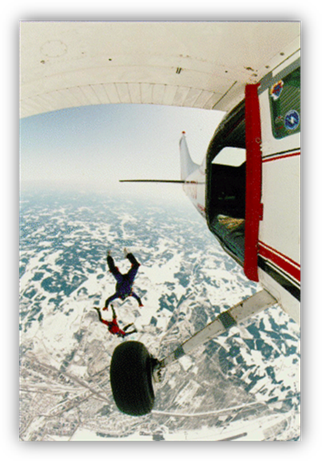
To keep our study somewhat
simple, we are going to look at some common conversions between kinetic and
potential energy in mechanical energy.†
This is one form that can be either potential or kinetic.† Looking at the picture of the skydivers, we
can see that they have a great deal of potential energy because they are very
far from the earth and height is one thing that determines the amount of
potential energy.† What happens the
second they jump from the plane?† They
begin to fall, and as they fall, they begin to pick up speed as any falling
object does.† That is why something
dropped from a greater height, hits the ground with greater impact than it
would if falling from a lower height.†
Since they are now moving, they have kinetic energy.† If they are picking up speed, their kinetic
energy is increasing.† Where did this
kinetic energy come from?† Except in the
case of nuclear reactions, energy cannot be created or destroyed.† This is known as the Law of Conservation of Energy.†
So, some of the potential energy of the divers must have been changed to
kinetic energy.† Why did this
happen?† If we look at the divers a few
seconds after their jump, we will notice that they are closer to the earth than
in the beginning of their jump.† This
means their height is less, so their potential energy is less.† Where did it go?† It changed into kinetic energy and will
continue to do so.† Other forces, such as
air resistance and the force exerted by the parachute, will eventually cause
the skydivers to slow down.
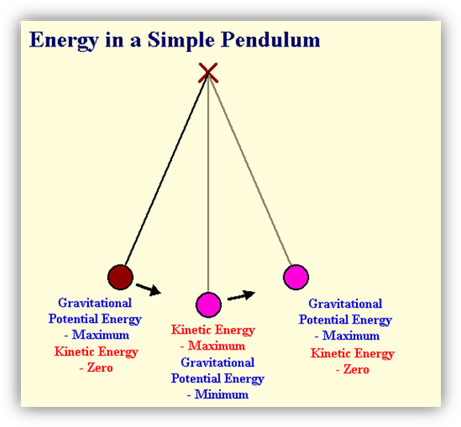
A simpler example of a
falling object would be a pendulum.† Even
though the bob of the pendulum is attached to a string, it still falls through
the air.† Since it only falls for a short
distance and therefore does not pick up much speed, it is not affected very
much by air resistance so we can neglect this effect.† (Air resistance is greater if the speed is
greater.† If you have ever stuck your
hand out of the window of a moving vehicle, you have experienced the feel of
greater air resistance at greater speeds.)†
When the pendulum is at the highest part of its swing, it has its
maximum potential energy.† At that point,
whether swinging to the right or left, its kinetic energy at that point is zero
because for that fraction of a second it is not moving.† It is changing its motion from going up to
going down.† If it is not moving, then it
has no kinetic energy or energy of motion.†
However, when it is at its lowest point (at the center of its swing) its
kinetic energy is at its greatest so it is moving as fast as possible.† This makes its kinetic energy as large as
possible.† Its potential energy is zero
at that spot, because it has no height. It is as low as it can get.† What happens when it is only halfway to the
bottom?† If the height is half of the
original height, then it has half of its original potential energy, the rest is
kinetic.†
††††††††††††††††††††††††††††††††††††††††††††††
This means the total amount
of mechanical energy in the pendulum remains constant but it is constantly
being changed from kinetic to potential and potential to kinetic. If it has ten
units of potential energy and zero units of kinetic energy at its greatest
height, then it will have zero units of potential energy and ten units of
kinetic energy at its lowest position.†
Halfway between these positions, it will have five units of potential
and five units of kinetic energy.†
Regardless of the pendulumís position, it will always have a total of
ten units of mechanical energy.† This is
in line with the Law of Conservation of Energy.†
A swing is a modified pendulum, so when you swing, you have maximum
potential energy at the height of your swing and maximum kinetic energy and
speed at the bottom of your swing when you are closest to the ground.
PhET Simulation
Click on the PhET icon below
to play with one or two pendulums and discover how the period of a simple
pendulum depends on the length of the string, the mass of the pendulum bob, and
the amplitude of the swing. It's easy to measure the period using the photogate
timer. You can vary friction and the strength of gravity. Use the pendulum to
find the value of g on planet X. Notice the anharmonic behavior at large
amplitude.
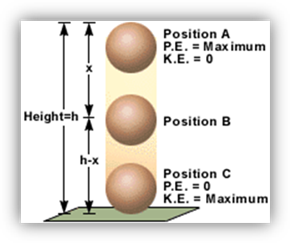 Another example of the mechanical energy of an object
changing from potential to kinetic energy is that of a ball being dropped.† Looking at the diagram on the left, the ball
is at its highest position at position A.†
Therefore, its potential energy is at its maximum or greatest
amount.† However, the ball is not moving
so it has zero kinetic energy.† At the
split second before the ball hits the floor, position C, the ball has no height
so its potential energy is zero.† All of
the potential energy has been changed to kinetic energy so its kinetic energy
is maximum at this point, which means it is moving at its greatest speed.† If position B is halfway between position A
and C, what can we say about the kinetic and potential energies there?† If you say that each energy is equal you
would be right!† Half of the energy is
potential and half is kinetic.† Because
the height is half of the original, it only has half of the original potential
energy.† The rest of that energy has been
turned into kinetic as the ball gains speed while falling.
Another example of the mechanical energy of an object
changing from potential to kinetic energy is that of a ball being dropped.† Looking at the diagram on the left, the ball
is at its highest position at position A.†
Therefore, its potential energy is at its maximum or greatest
amount.† However, the ball is not moving
so it has zero kinetic energy.† At the
split second before the ball hits the floor, position C, the ball has no height
so its potential energy is zero.† All of
the potential energy has been changed to kinetic energy so its kinetic energy
is maximum at this point, which means it is moving at its greatest speed.† If position B is halfway between position A
and C, what can we say about the kinetic and potential energies there?† If you say that each energy is equal you
would be right!† Half of the energy is
potential and half is kinetic.† Because
the height is half of the original, it only has half of the original potential
energy.† The rest of that energy has been
turned into kinetic as the ball gains speed while falling.
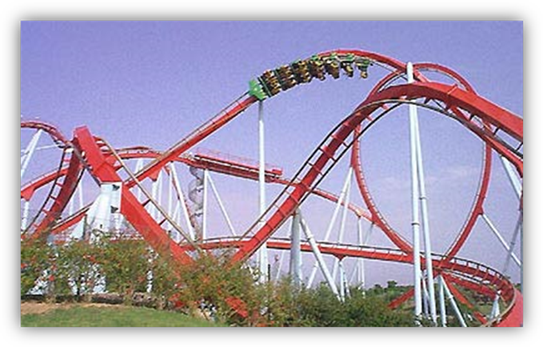
Lastly, letís consider the
roller coaster, a great example of the conversion from potential energy to
kinetic and back to potential.† At the
beginning of this lesson we briefly discussed the lift hill of the coater.† It is at the top of this hill that the
coaster has its greatest potential energy because its height is greatest
here.† As the coaster goes down the lift
hill, it constantly picks up speed.† What
about the energy?† If it is picking up
speed, then it is gaining kinetic energy.†
But, since it is now not as high in the air as it once was, it has lost
potential energy.† At the bottom of the
lift hill, its lowest point, its speed is at maximum.† Therefore, it has maximum kinetic
energy.† Then what happens as it starts
up the next hill?† It is going up so it
is gaining potential energy, but it is also slowing down, so it is losing
kinetic energy.† At the top of this hill,
it still has some kinetic energy because it is still moving although not as
fast as it did at the bottom of the lift hill.†
Some of that kinetic energy is now potential energy because the coaster
has gone up in the air somewhat.† And so
it goes throughout the ride.† The coaster
gains kinetic energy as it falls and gains potential as it rises.† In reality though, the coaster can never go
as high as it went on the lift hill.†
Friction between the carts and the rails continues to slow it down by
creating some heat energy, which robs the coaster of useful energy.††††
Unit Conclusion
The seven forms of energy can
be further classified as either kinetic or potential depending upon whether the
energy is stored or being actively used.†
Furthermore, kinetic and potential energy can be transformed from one to
the other.† In simple systems where there
are no external forces acting on the objects, the total amount of energy
remains constant as in the case of a falling ball or a pendulum.† Other examples of this conversion that do
include external forces, namely friction and air resistance, are roller
coasters and skydivers.† In these cases
the mechanical energy does not remain constant.
